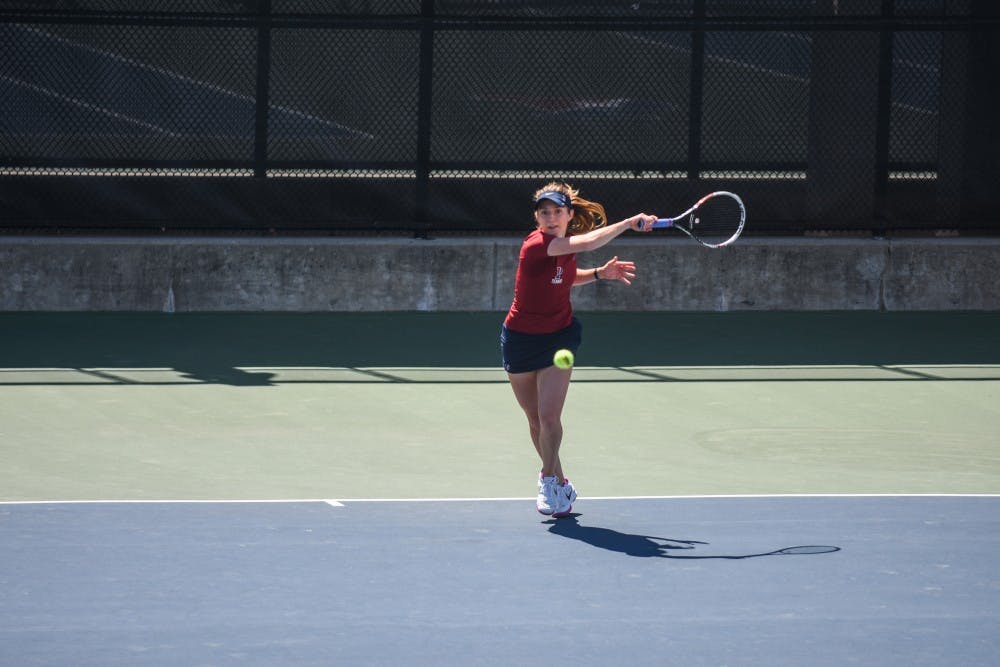
Senior Marta Kowalska is one of a trio on Penn women's tennis who serve underhand in matches.
Credit: Alexa CotlerPenn women’s tennis has taken an underhanded approach to winning matches this season.
While overhand serves may be the sport’s convention, nearly half of the players for the Red and Blue make use of an unconventional tactic to come out on top: underhand serves.
Senior Marta Kowalska, who plays at second singles and first doubles for the Quakers (16-5, 5-2 Ivy), started using underhand serves last year so that she could play despite a severe shoulder injury.
“My pain was like a nine out of 10," Kowalska said. “I was going to play another match against my teammate the next day and I told my coach, 'I can’t play, I just can’t serve.'"
Kowalska's coach suggested that she try serving underhand, but at she was reluctant to try out a new tactic at first.
“I said ‘no’ — first of all, she’s just going to start hitting winners off of every return, and also, that is just so embarrassing. I don’t want to do that,” Kowalska said. “There’s this negative connotation with underhand serves … it’s usually the sign of someone not being able to serve overhand well.”
But when her shoulder wasn’t getting any better, Kowalska decided to give underhand serves a try.
“My other choice was just to give up and not play at all. If I wanted to play, serving underhand was the only possibility.”
Because of her injury, Kowalska ended up using her underhand serve for the entirety of the 2018 season. By the start of 2019, Kowalska was able to serve overhand for the majority of her games, but she made sure to utilize the skill she had mastered in the previous season.
“I was just mixing it up this year. Mostly overhand, but mixing in underhand serves — I played them so much last year that they were good — it helped me by getting my opponents confused and it’s not so easy to respond to it,” Kowalska said.

Sophomore Marija Curnic
By the start of this season, Kowalska wasn’t the only Quaker doing underhand serves. Two of her teammates, junior Carolyn Xie and sophomore Marija Curnic, also started using them.
Xie, who plays at third doubles, was injured for the first two seasons of her college career and decided to try serving underhand coming into her junior season to prevent another injury.
“We decided that it was best to preserve my body — especially coming back from two back-to-back serious injuries — to go with the underhand serve 100% of the time. I didn’t do one overhand serve all season,” she said.
Xie was surprised at how well the underhand serves worked in both throwing off her opponents and in causing unforced errors on their behalf.
“The first thing I realized was how many errors I actually drew [from my opponents]. I expected them to just crush it or for it not to be effective. But I got errors and then typically they just try to make it in play so it’s pretty easy to hit afterwards,” Xie said. “Part of it is just visual … when you’re returning and you see your opponent not take a normal swing, you get a little thrown out of position. And then the actual ball is hard to hit because it’s not a traditional spinning off the court.”

Junior Carolyn Xie
Though she’s not coping with or preventing an injury, Curnic was inspired by her teammates to add an underhand serve to her repertoire at first doubles and third singles for when she runs into trouble with her regular overhand serves.
“Marta was doing it, Carolyn was doing it, and it actually worked well. I always have it in the back of my mind and it gives me more confidence because I know in case my serve is not doing well that day, I know I have that other option,” Curnic said.
But similar to Kowalska, Curnic initially thought that serving underhand would be embarrassing.
“Before coming to Penn, I’d never served underhand in my life. When I came to college, I realized that sometimes under pressure you start doubting your shots and can’t perform your best … My coach suggested I serve underhand if that was the only way I could put the ball on the court,” Curnic said. “For me it was kind of weird, but then I realized, if that’s what it takes to win, I’m willing to do whatever it takes."
Underhand serves were not the first choice for this trio, but they had to set aside their preconceived notions about a tactic that could ultimately help them win more matches.
“We had to make this mental switch where we accept that an underhand serve is fine. It’s not an embarrassing thing, it’s just like a type of serve,” Kowalska said. “We want to win and we’re going to do whatever it takes to win. If you can learn how to handle the game after, and if this is what puts you in the game, then you have to do it."
Serving underhand may be considered a sign of weakness in much of the tennis world, but for Penn women’s tennis, underhand serving has proved to be its not-so-secret weapon.
The Daily Pennsylvanian is an independent, student-run newspaper. Please consider making a donation to support the coverage that shapes the University. Your generosity ensures a future of strong journalism at Penn.
Donate



